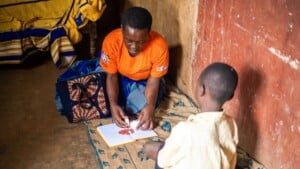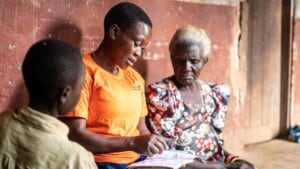The Case for Strengthening the Social Service Workforce to End AIDS in Children
January 31st, 2023 | Blogs
The Bantwana Initiative applauds the implicit call in a recent New York Times article, Global Push to Treat H.I.V Leaves Children Behind, to re-focus efforts to address treatment gaps for children living with HIV in sub Saharan Africa, home to 90% of all children living with HIV (WHO, 2011). This article underscores the importance of funding partners like PEPFAR and the Global Fund already championing these efforts, as well as the vision of the newly established Global Alliance to End AIDS in Children by 2030, a UNAIDS, UNICEF, and WHO-led consortium of funders, governments and other development partners.
There is indeed a need for urgent action through robust efforts to strengthen government health systems. However, evidence tells us that solutions for reaching and treating children must include family- and community-based approaches that go beyond the clinic setting to address the complex socio-economic factors that impede children’s treatment access and continuation.
For more than a decade, the Bantwana Initiative of World Education has worked at the intersection of health, child protection, and social services to address HIV treatment gaps in children across southern and eastern Africa. As a community partner alongside clinic teams, Bantwana works within a local referral network and structured, community case management approach to coordinate and deliver holistic services to vulnerable children, including thousands of those living with HIV. This approach is anchored by an array of trained case workers — the frontline social service workforce — who monitor and follow up up with children and caregivers in the communities and homes where they live. Thus, the work of thousands of skilled community case workers and social workers we support extends the arm of the clinic into the community to find, link, and retain children and families living with HIV with the holistic supports they need to achieve health as well as the financial and social stability to effectively manage HIV over the long term.

As sources in the article point out, the challenges to effective case finding — identifying children most vulnerable to HIV and getting them tested and treated — are daunting. Recent efforts by Ministries of Health, in collaboration with donors and other key stakeholders, have accelerated effective targeting of the most vulnerable children through data-driven approaches. However, as a UNICEF colleague quoted in the article rightly states, children are harder to find and test and treat as they rely on their caregivers to access care. Improving case finding means understanding and addressing caregiver constraints or fears. For example, for women, who represent the vast majority of primary caregivers across the continent, this includes family and community stigma, the impacts of disclosing their HIV status to their partners, and lack of testing access due to poverty, among others.
The article also points out the twin challenges of drug stock outs and stigma in reducing mother-to-child transmission. A serious hurdle, drug stock-out is a financial and logistical challenge that is largely transactional, in contrast to the stigma, economic, physical, and emotional threats women face related to HIV testing and treatment. Solutions to these hurdles are not transactional, but relational, dynamically playing out in families and communities at different points in time, and are more likely to be overlooked or unseen during busy clinic visits.
Drugs and data are critical, essential pieces of a targeted roadmap and durable solution, but they are not enough to close the gaps to children’s treatment outcomes. They don’t help 22-year-old Ashura*, a young woman living in rural Uganda, to get the support she needs to disclose her status to her new husband. They don’t help coach her about how to talk to her husband about testing, provide and monitor her treatment until her baby is born, or support her through the 18–24-month period of testing and treatment to mitigate mother-to-child transmission. They don’t help to ensure she gets regular, nutritious meals every day, or break the isolation she feels as a new mother.

Similarly, drugs and data aren’t enough to help caregivers like Eva, the grandmother of 13-year-old Delphine*, to summon the courage or access support from trained clinic teams to disclose her child’s HIV status to her — and then deal with the ensuing anger, sadness, and fear. They do not help Eva and Delphine work through those emotions or strengthen coping skills and resilience to daily stresses, nor address family food security or costs of school fees and clinic transport, all of which are proven to support children’s treatment outcomes and reduce vulnerability to violence, especially for girls.
This is the work of the frontline, community social service workforce. Case workers like Martha, a mother living with HIV, whose lived experience and knowledge of her community and social service networks has enabled her to provide consistent, structured support to Esther*, a 15-year adolescent mother living with HIV.
My husband abandoned me when I was pregnant,” explains Martha. “So, I understand what women and children go through. That’s why I work hard to support them and ensure that they are protected and living fulfilling lives.”
No longer in school, Esther lives with her mother (also HIV positive) and her younger sister who is HIV negative. Martha visits Esther regularly to reinforce exclusive breastfeeding, treatment adherence, and to encourage her to pursue her goal of starting a microbusiness by joining a local savings group. These steps have given Esther courage and broken the cycle of shame she feels as an out-of-school adolescent mother.
Thousands of women and men like Martha work tirelessly at the intersection of health, child protection, and social services across thousands of rural communities in sub–Saharan Africa. This arsenal of front-line responders coordinate critical holistic services to children and families living with HIV.
The ongoing, collaborative action from donors, government, and development partners is encouraging and hopeful. And, even as we actively support efforts to build more robust health systems, we will continue to advocate for investments in social service workforces as an essential element for ending HIV in children.
*Names have been changed to protect confidentiality.
World Education fosters enduring partnerships across regions and sectors to advance education outcomes for all. We offer education systems strengthening, program design and implementation, applied research and evaluation, capacity development, and policy development services.